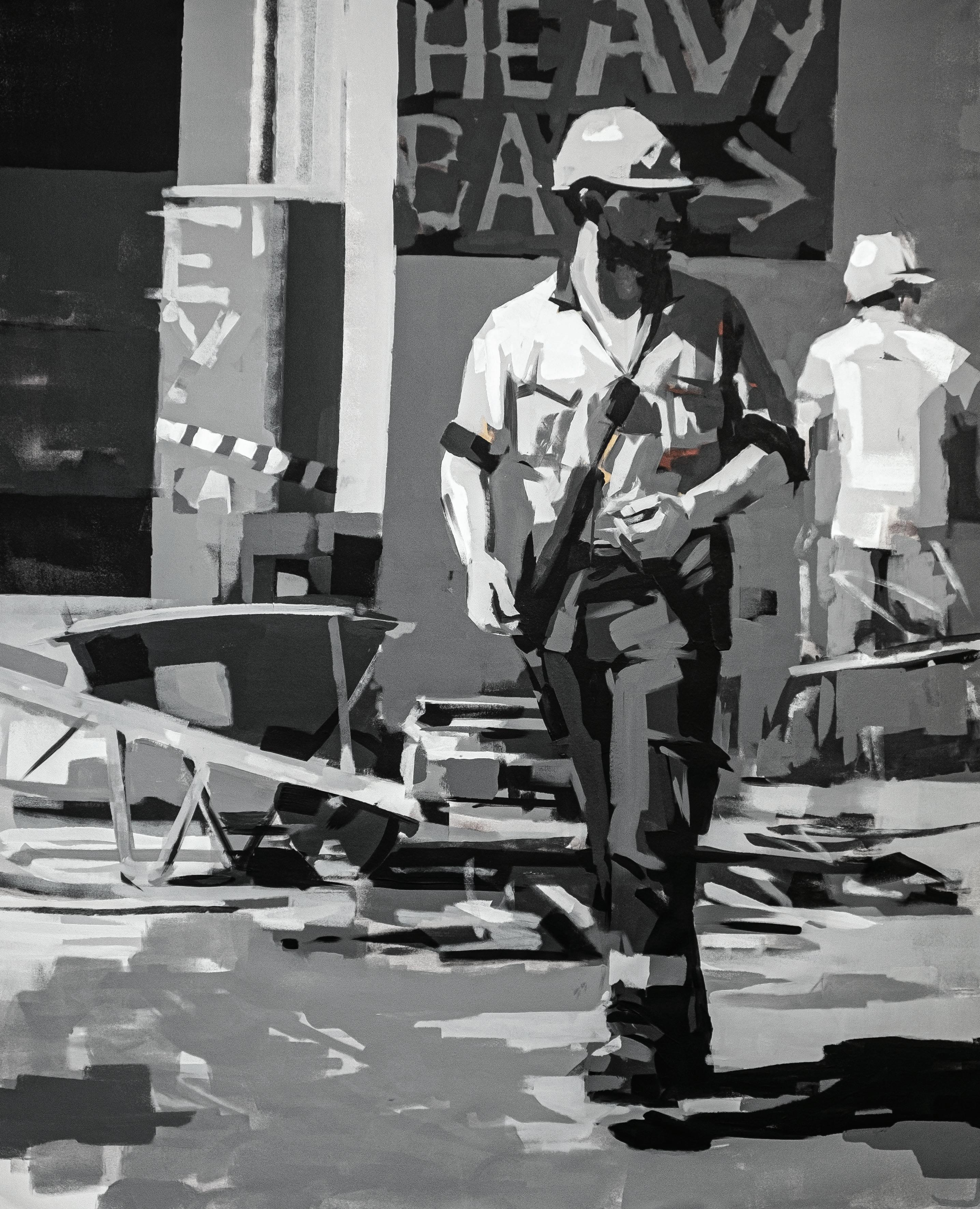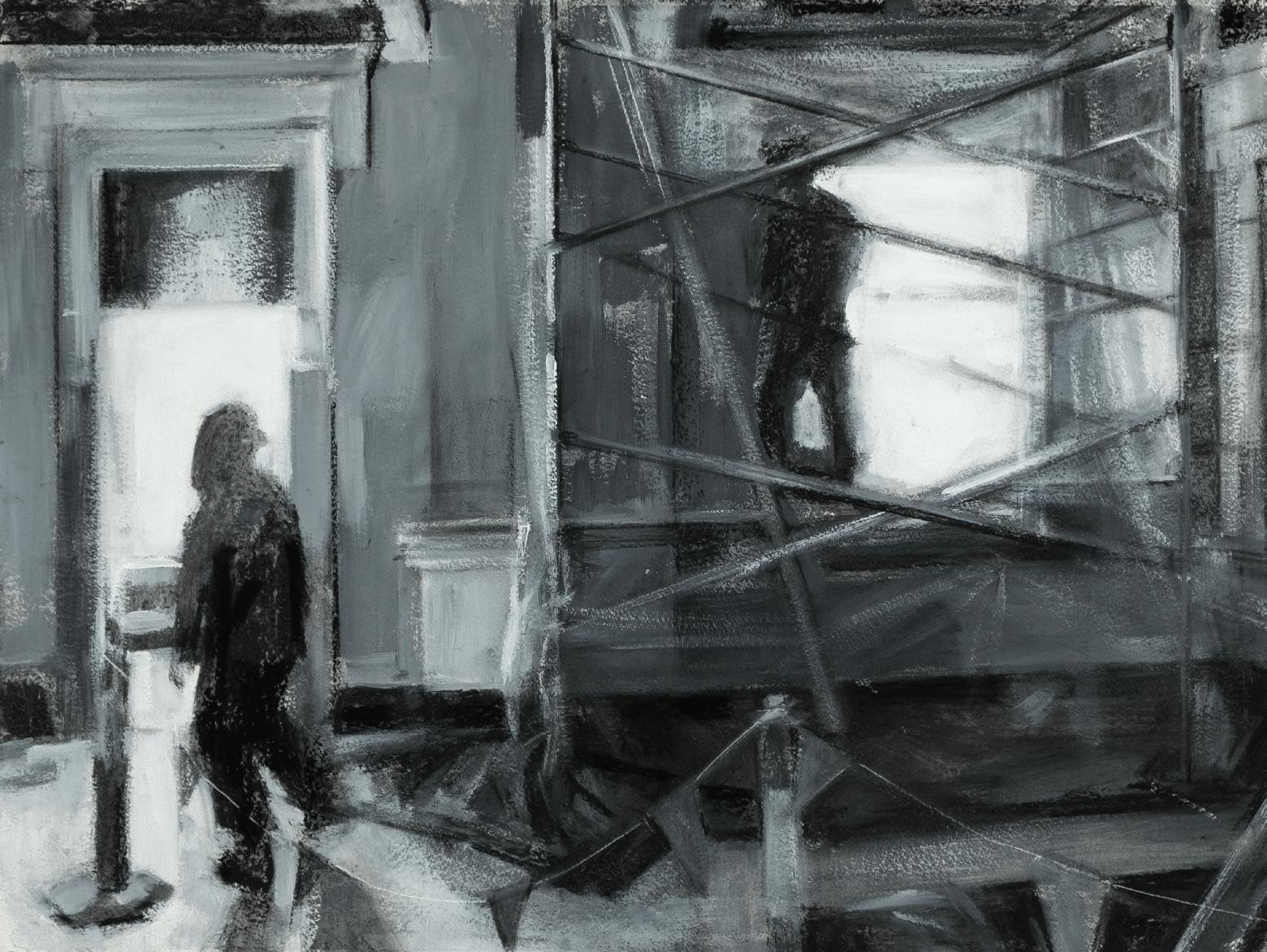
3 minute read
Andrea Huelin: Men and Cones
On initial introduction to an artist’s work, it is intriguing to discover the fundamental aspects that make the artist’s vision their own. Choice of genre, and whether it is abstract or representative, are some of the first indicators along with medium and techniques, for example the painterly qualities of the work, marks revealing the artist’s hand, and so on. Additional elements that differentiate artists can be seen in the decisions they make, how they sort the relevant from the unnecessary or what they choose to be emphasised or supressed.1 Insight might also be gained by means of viewing the subject matter and pictorial arrangement. The importance of these may vary; the former establishing the artist’s interests to a viewer, while the latter signals their intentions related to composing those interests.
In broad terms, Andrea Huelin’s subject matter for Men and Cones encompasses the human figure within a landscape. The type of figure and the landscape in which they reside though, is specific. Figures of labour, trades people, and machine operators occupying an industrial environment within the urban landscape, are readily familiar, yet on recollection rarely given more than a passing glance when encountered. Worksites of this nature have a generative impression when experienced in person through distinct sounds and actions, making us aware that something is being constructed or maintained, something is being produced. The labourer’s location amid the urban mass of concrete and steel, at times places their actions akin to being on stage; seen by the public often, but seldom intentionally observed.
Huelin maintains a preoccupation with human activity found in these worksites or industrial situations. Her observations of many and varied workplaces over a number of years, from factory or warehousing types, to heavy industries such as mining and construction, have helped develop a type of affinity with the industrial worker. The narrative of these sites, their hi-vis uniforms, associated ensemble of tools and machinery, and the spaces they inhabit, supports the opportunity to visualise people during the course of going about their working routine. In addition, the uniform has the now commonplace saturated colours of orange and yellow with reflective stripes encircling the body, arms, and legs, propelling the figure to stand out. Originating from observations of sites around Cairns, these works carry common themes of interest to Huelin such as human movement, actions, and demeanor.
Figures dominate the larger works, though not with a sense of saturated colour and fine detail. Rather, these works are for the most part, monochromatic, and built up with flat layers of paint that is more in keeping with the limited tonal range and assortment of flat planes in the urban landscape surrounding the subject.
Huelin takes on the challenge of working with a limited palette, using deliberate, blocking type marks of varying weight to shape, and emphasise the figures against a similarly muted background. Regular conventions relating to spatial relationships are suppressed for a preference of lost and found edges and simplified tonal values across the frame. At times, the edges and boundaries identified throughout the composition display both connection and disconnection with marks of light, letting the viewer know that a spatial relationship exists.
The urban landscape provides much diversity for artists, with an interest in pictorial arrangement and form in two-dimensional work. Particularly those where smaller figures are set among geometrically orientated objects such as buildings, industrial sheds, and the fixed edges of their shadows. The smaller works reveal much more of the urban workplace ensemble, relegating the figure to a lesser, but not subordinate position, in the composition. The figure in these cases maintains an essence of human action in the absence of detail through blocking marks that reinforce geometric properties of form in the figure.

Pictorial arrangement on these occasions allows the artist to substantiate that which they deem relevant among geometric qualities by using decisive marks to simplify what would otherwise be complex urban forms which ground the figure. Included in this creative synthesis might also be conventions of space, the artist’s choice of medium, and in the case of Huelin’s work, acceptance that detailed analysis is unnecessary to realise a personal vision.
Subject matter, and placement of objects and space in the picture plane lays out just part of an artist’s visual communication. In addition to these, individual intuition steps in as work progresses for all manner of decisions such as colour and tonal balance, the type of marks to use, and what is either relevant or unnecessary to communicate the artist’s vision. Through amalgamation of observations from personal lived experience of the worksite, and studio-based translation of those observations to the picture plane, one is a step closer to a more complete account of that which makes the artist’s vision their own.

Galleries Team
Wendy Bainbridge Gallery Assistant
Jonathan Brown Education and Programs Assistant
Erwin Cruz Senior Collections and Exhibitions Officer
Rachel Cunningham Education and Programs Officer
Michael Favot Gallery Assistant
Veerle Janssens Gallery Assistant
Dr Judith Jensen Team Manager, Arts
Jo Lankester Collections Management Officer
Amy Licciardello Business Support Officer
Chloe Lindo Gallery Assistant
Dr Jonathan McBurnie Creative Director
Ashleigh Peters Gallery Assistant
Jake Pullyn Exhibitions Officer, Projects
Sarah Reddington Senior Education and Programs Officer
Tanya Tanner Public Art Officer
Lucy Belle Tesoriero Curatorial Assistant
Abbi Thomas Business Support Trainee
Leonardo Valero Exhibitions Officer


